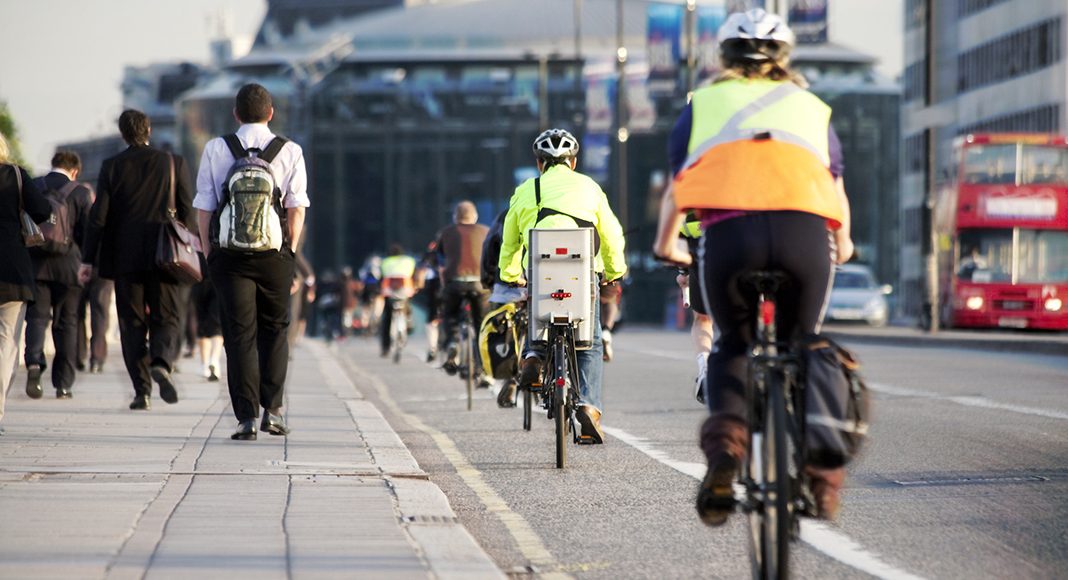A just-published study into the risks of cycling in London, UK, has found that roads with more cyclists are safer. The researchers who carried out the study said a simple âphysicalâ explanation could be that more cyclists on a route means less exposure per cyclist. A âbehavioralâ explanation could be that drivers on routes with high cyclist volumes are more aware of cyclists and take more care.
Road type was found to be particularly influential to safety, with residential streets substantially safer than other street types. Added to this, 20 mph roads were found to have 21 percent lower odds of injury for cyclists, compared with 30 mph roads.
âThe results support a range of interventions to improve cyclist safety, including 20 mph zones, reducing levels of motor traffic, and building routes that get more people cycling,â said report author Dr. Rachel Aldred. âThe study contributes to a growing evidence base on interventions that improve safety for vulnerable road users, so drivers, cyclists, and pedestrians can better understand what needs to change on the roads and why.â
A separate report has found that bikeshare schemes are another plus for cyclist safety. The Mineta Transportation Institute says that such schemes help to reduce bicycle collisions and that riding a shared bicycle is safer than riding a personal one. Why? Because shared bikes are heavy, have only a few slow gears and put the rider in an upright position, encouraging slower riding. Added to this, their color and lights make them instantly recognizable, alerting car drivers to be more careful.
âWhile some experts believed casual users were more error prone because of less familiarity cycling with traffic, they believed this inexperience was compensated for by greater attention, defensive cycling, and motorists who were more forgiving of bikesharing riders,â stated the report, Bikesharing and Bicycle Safety.
Itâs evident that some roads, in some areas, are seeing improvements in safety for cyclists. But, in 2016, 840 bicyclists were killed in crashes with motor vehicles in the U.S. in 2016; thatâs the highest number of bicyclist deaths since 1991.
Yet this is against a backdrop of a dramatic increase in the number of cyclistsâalmost 50 percent from 47 million in spring 2008 to 66 million in spring 2017. Take a look at the number of bicycle sales and itâs clear they far outnumber cars. Passenger car sales went down from 7.9 million in 2014 to 6.3 million in 2017, while in 2015 (last figures available), around 17.4 bicycles were sold in the U.S.
The National Highway Traffic Safety Administration (NHTSA) says that more Americans are choosing to use bicycles to commute, for exercise, or just for fun. Bicycle commuting alone saw nationwide growth of 51 percent between 2000 and 2016.
With more cyclists on the roads, itâs up to all road users to share the road safely
âWe encourage bicyclists and motorists to put safety first,â said NHTSA Deputy Administrator Heidi King. âTake simple precautions – remain focused to the road and the traffic around you; anticipate what others may do, before they do.â
Here are NHTSAâs safety tips:
Bicyclists:
- Wear a properly-fitted helmet that meets the Consumer Product Safety Commission (CPSC) standards
- Check your bike equipment before heading out: check for proper fit and function, including tires, brakes, handlebars and seats
- Ride in the same direction as traffic, as a vehicle on the road
- Obey traffic signs, signals, and lane markings; signal all turns; and follow local laws
- Be predictable; ride in a straight line and use hand signals when changing lanes or turning
- Stay focused; look ahead for traffic and obstacles in your path
- Be visible: wear bright colors, reflective materials and lights on your bicycle at night and in low light conditions
- Stay alert: donât use electronic devices
- Ride safe; riding impaired by alcohol or drugs affects your judgment and skill; it affects your safety and others on the road
Motorists:
- Pass bicyclists on the road with care; allow at least three feet clearance
- Look for cyclists before opening a car door or pulling out from a parking space
- Yield to bicyclists at intersections and as directed by signs and signals
- Look for bicyclists before making turns, either left or right
- Respect designated bicycle lanes; donât use them for parking, passing or turning
- Never drive distracted or impaired. Always buckle up
Did you know? In Davis in California, 16.6 percent of journeys to work are made by bicycle, earning it first place on a list of cities with the highest share of bicyclists.
eDriving has tips about sharing the road with cyclists along with tips for many other driving situations todayâs motorists face. See all of our guides here.
Â



















